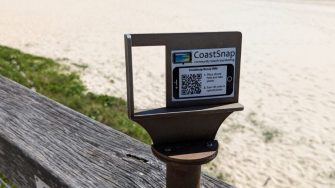Capturing Change with CoastSnap
Join the thousands of citizen-scientists helping to protect Australia’s coast with their mobile phone cameras
Join the thousands of citizen-scientists helping to protect Australia’s coast with their mobile phone cameras

With 87% of Australia’s population living along the coast, it is no secret that the country’s beautiful beaches hold a special place in most Aussie hearts.
Recognising the strong emotional connection the community has to the coastline, Dr. Mitchell Harley at the UNSW Water Research Laboratory saw an opportunity to involve them in his research.
After a storm in 2016 caused intense coastal erosion in the Sydney suburb of Collaroy, the coastal team at the Water Research Lab – comprising Dr. Harley, fellow researchers Associate Professor Kristen Splinter and Professor Ian Turner, and UNSW students – began developing tools and systems to analyse changing coastlines and better inform communities, residents, businesses and governments about the impacts of coastal erosion.
“We saw that storm coming many days in advance – we're a bit like storm chasers in a way,” says Dr. Harley. “At the time, we mobilised with a whole range of coastal monitoring equipment to measure the site and obtain data before and after impact was made.”
The team even worked closely with UNSW Aviation, using their twin-engine aeroplane to help scan the coast and capture measurements of changing shorelines.
Realising they needed a broader collection of time-series data that would enable researchers to track changing coastlines beyond the local and regional scale, Dr. Harley began developing an innovative tool to encourage members of the public to contribute their own photos of sandy coastal areas around the world.
“It led to this crowdsource kind of approach called CoastSnap,” he explains.
CoastSnap is a low-cost community beach monitoring technology that turns mobile phone photos into coastal monitoring devices. “We’ve developed algorithms to use the photos people take and turn them into mini satellite images, which allows us to track the shoreline.”
The team started by installing stainless steel smartphone cradles overlooking beaches, which people could place their phones into and take a snap. “They’re always at the same location, so it’s always the same photo,” adds Dr. Harley. “Over time we’ve gotten this incredible record of changes, all crowdsourced from the community.”
The very first CoastSnap camera cradle station was installed at Manly Beach on Sydney’s Northern Beaches in May 2017. Since then, the project has grown to 350 stations across 30 countries, making CoastSnap the largest coordinated, land-based coastal monitoring program worldwide.
As coastal erosion continues to be a significant issue for Australia and the world, Dr. Harley and A/Prof. Splinter hope their work can have an enduring outcome and impact.
“Hopefully our work will allow us to continue living, working and playing in the places that we love,” says A/Prof. Splinter. “That can only come about through better understanding of how our coastlines are changing, and ensuring we plan accordingly.”
As Australia’s best engineering faculty turns 75, there are just as many reasons why we’ve earned that title. Discover new stories weekly, celebrating the successes that have enabled progress for all.